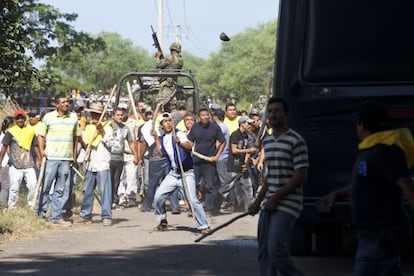No relief from terror in Mexico’s Michoacán state
Drug traffickers and vigilantes continue to up the ante in cities


Judging by the celebrations that took place Friday night in the main square in Tepalcatepec, no outsider would conclude that this small city in Michoacán state is at war.
Hundreds of residents gathered in the square to watch a beauty contest held to select the queen who will represent the municipality in a regional pageant. Three 16-year-old girls took to the stage, swaying their hips, while two twins, Francia and Grecia, sang traditional Mexican ballads as background music.
The fact that a violent struggle between armed citizen vigilantes and drug traffickers has put Tepalcatepec in the middle of an internecine war was far from everyone’s minds last Friday, with the exception of a few parents.
“There are going to be some surprises tomorrow. Who knows what will happen,” whispered two women in the crowd amongst themselves.
At 3.30pm Saturday, Michoacán was rocked by violence. Several grenades exploded in the main square of nearby Apatzingán, a city of 124,000 residents, located 500 kilometers from Mexico City, in the middle of the Tierra Caliente region, where the drug cartel Caballeros Templarios has been terrorizing residents.
The attack at the square, which also saw sharpshooters take positions on the roof of the cathedral and the city hall, as well as from inside a nearby pool hall, broke out about 30 minutes after a vigilante group from six neighboring municipalities arrived in Apatzingán to “free the city from organized crime.”
Citizens began taking up arms in February in many towns across Michoacán when about 3,000 people began forming convoys of 200 vehicles that started from San Juan de los Plátanos, about eight kilometers from Apatzingán. It took five hours for this latest march to arrive at its destination because police and military officers prevented them from getting through on two occasions.
For two months, the hitmen were waiting at my door every 15 days to collect [$2,700]”
“We are not criminals,” said one vigilante. “They should protect us from them, but instead they are arresting us and taking away our weapons.”
Eventually law enforcement authorities let them go by, but without their firearms. “If they kill us, they kill us,” said one man, whose wife was expecting a baby in three days’ time.
“Our communities are safe because of these brave men,” said María José, 42, who was in Tepalcatepec square on Friday.
Men from around 30 communities in the region have decided to organize themselves as vigilantes — community protection squads — after becoming fed up with the abuses and threats perpetrated by organized crime gangs. “For two months, the hitmen were waiting at my door every 15 days to collect 35,000 pesos[$2,700],” said one teacher.
Police said that the Caballeros Templarios (Kinghts Templar) — a spin-off faction of the Familia Michoacana drug cartel — are led by former schoolteacher Servando Gómez Martínez, who was responsible for 30 murders across the region last July. The terror has been so great that some federal police officers fear for their lives.
“There are some towns where we cannot enter because many of our men have been gunned down,” said one officer on Saturday.
The vigilantes had planned on calling a town meeting in Apatzingán before the attack. “We wanted the people to support us, and just say no to the violence,” said José Manuel Mireles, one of the most visible spokesmen of the vigilantes.
But the grenades and the shootings scared many away, with people sent running for their lives, according to witnesses. After a shootout with military and federal police officers that lasted some minutes, the hitmen fled. Three people were injured.
“I can't understand why they disarm us but the others still have weapons,” says Mireles.
The incident in Apatzingán was followed by more early-morning attacks on filling stations and electricity plants in Morelia and nine other municipalities. The incidents caused power blackouts in the surrounding areas. By daybreak, authorities had found five bullet-ridden bodies.
Tu suscripción se está usando en otro dispositivo
¿Quieres añadir otro usuario a tu suscripción?
Si continúas leyendo en este dispositivo, no se podrá leer en el otro.
FlechaTu suscripción se está usando en otro dispositivo y solo puedes acceder a EL PAÍS desde un dispositivo a la vez.
Si quieres compartir tu cuenta, cambia tu suscripción a la modalidad Premium, así podrás añadir otro usuario. Cada uno accederá con su propia cuenta de email, lo que os permitirá personalizar vuestra experiencia en EL PAÍS.
¿Tienes una suscripción de empresa? Accede aquí para contratar más cuentas.
En el caso de no saber quién está usando tu cuenta, te recomendamos cambiar tu contraseña aquí.
Si decides continuar compartiendo tu cuenta, este mensaje se mostrará en tu dispositivo y en el de la otra persona que está usando tu cuenta de forma indefinida, afectando a tu experiencia de lectura. Puedes consultar aquí los términos y condiciones de la suscripción digital.
Últimas noticias
Maduro pleads not guilty before the federal court in New York: ‘I am still the president of Venezuela’
A new test can detect Alzheimer’s from a finger prick
UN team enters Sudanese city of El Fasher after paramilitary massacre: ‘It’s like a ghost town’
A recipe for resistance: Indigenous peoples politicize their struggles from the kitchen
Most viewed
- Gilles Lipovetsky: ‘If you want to live better and fall in love, take Prozac, don’t look to philosophy’
- Alain Aspect, Nobel laureate in physics: ‘Einstein was so smart that he would have had to recognize quantum entanglement’
- Alvin Hellerstein, a 92-year-old judge appointed by Bill Clinton, to preside over Maduro’s trial in New York
- Maduro’s downfall puts China’s relationship with Venezuela to the test
- Why oil has been at the center of Venezuela-US conflicts for decades








































